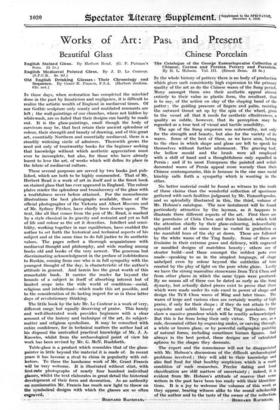Works of Art : Past and Present
Beautiful Glass
English Mediaeval Painted Glass. By J. D. Le Couteur. (S.P.C.K. 8s. 6d.)
IN those days, when restoration has completed the mischief done in the past by fanaticism and negligence, it is difficult to realize the artistic wealth of England in mediaeval times. Of our Gothic sculpture only scanty and mutilated remnants are left ; the wall-paintings of our churches, where not hidden by whitewash, are so faded that their designs can hardly be made out. It is the glass-paintings, small though the body of survivors may be, that best retain their ancient splendour of colour, their strength and beauty of drawing, and of this great art, essentially Northern and essentially mediaeval, there is a steadily widening circle of admirers. Therewith grows the need not only of trustworthy books for the beginner seeking that knowledge without which aesthetic appreciation must ever be incomplete, but also, for those who have already learnt to love the art, of works which will define its place in the fabric of mediaeval culture.
These several purposes are served by two books -just pub- lished, which are both to be highly commended. That of Mr. Herbert Read is a work of art in itself and is the finest book on stained glass that has ever appeared in England. The colour plates render the splendour and translucency of the glass with a truthfulness never before attained. For the monochrome illustrations the best photographs available, those of the official photographer of the Victoria and Albert Museum and of Mr. Sydney Pitcher, have chiefly been drawn upon. The text, like all that comes from the pen of Mr. Read, is marked by a style classical in its gravity and restraint and yet as full of life and colour as the art it describes. Intellect and sensi- bility, working together in rare equilibrium, have enabled the author to set forth the historical and technical aspects of his subject and at the same time to do full justice to its aesthetic values. The pages reflect a thorough acquaintance with mediaeval thought and philosophy, and wide reading among books old and books of the very newest. The generous but discriminating acknowledgment in the preface of indebtedness to Ruskin, coming from one who is in full sympathy with the youngest thought of the day, is characteristic of the author's attitude in general. And herein lies the great worth of this remarkable book. It carries the reader far beyond the bounds of a subject in itself of absorbing interest but of limited scope into the wide world of conditions—social, religious and intellectual—which made this art possible, and to the consideration of its lasting import for us in these latter days of revolutionary thinking.
The little book by the late Mr. Le Couteur is a work of very, different rangeT but equally deserving of praise. This handy and well-illustrated work provides beginners with a clear account of the history and technique of the art, its subject- matter and religious symbolism. It may be consulted with entire confidence, for in technical matters the author had at his disposal the unrivalled practical knowledge of Mr. J. A. Knowles, whilst from the archaeological point of view his work has been revised by Mr. G. MeN. Rushforth.
Table-glass is a product which resembles that of the glass- painter in little beyond the material it is made of. In recent years it has become a rival to china in popularity with col- lectors. To these the handsome work of Mr. Grant Francis will be very welcome. It is illustrated without stint, with first-rate photographs of nearly four hundred individual glasses, whilst the text elaborates in great detail the historical development of their form and decoration. As an authority on numismatics Mr. Francis has much new light to throw on the symbolical designs with which the glasses are so often engraved.
BERNARD RAORDAllfs--






























































 Previous page
Previous page